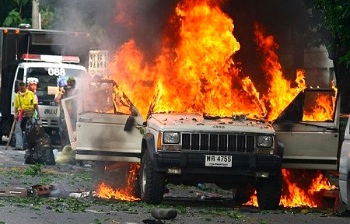[This essay was written for the Media Entertainment & Arts Alliance‘s report Life in the Clickstream: The Future of Journalism [PDF], to be launched in Melbourne today. It was published under the title “Smart brains find ways to spread the message” and trimmed to fit the space available. This version includes all of the extracts from @smartbrain’s Twitter stream which I’d originally supplied.]
Bangkok, 7 October 2008. A Jeep explodes near parliament, killing a man. Body parts are thrown up to 20 metres.
Meanwhile, 5,000 members of the royalist People’s Alliance for Democracy are occupying the Government building grounds — well-organised but largely peaceful. Thailand’s Constitutional Court forced Prime Minister Samak Sundaravej to resign a month earlier, but his successor Somchai Wongsawat is seen as a corrupt puppet. PAD has given him until 6pm to resign. He does not. The car bomb detonates. The ultimatum expires. The demonstration explodes into riot.
Tear gas. Gunfire. 381 injured. Another death. It’s the worst violence in 16 years.
Meanwhile, in Sydney, my ex-pat Thai partner and I are sinking beers. We take our laptops online but not even Thai news outlets say what’s happening now.
Then, using Twitter, we find @smartbrain.

